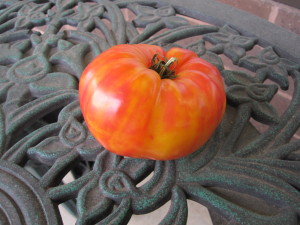Tips for Growing Tomatoes
I heard it a lot when I talked to gardeners last summer, and the summer before that: “My tomatoes are doing terrible—I don’t know what I did wrong!”

People are understandably disappointed when the plants they’ve carefully tended and nurtured fail to produce the bountiful crop they dreamed about all winter, and they assume that they somehow messed up. I tell them not to worry, because it probably wasn’t their fault. In fact, if you tried growing tomatoes in the last two years and noticed they weren’t producing any fruit for a long period of time, there was a very simple reason for it: July
The month of July in both of the last two years was notable for extended periods of scorching hot and unbearably humid weather. In 2011, July 20th set the record for the highest dew point ever recorded in the Twin Cities. Those are factors that tomatoes don’t like.
Now I know some people claim that tomatoes thrive in really hot and muggy weather. Not true. Tomato plants rely on their pollen to be shaken loose from the anthers in the flower—either through the action of the wind or a pollinator like a bee—so that it lands on the stigma and pollinates it. When the temperature rises above 90 degrees with high humidity, the pollen becomes sticky and won’t shake loose. The result: in a long spell of excessively hot and humid weather an entire bloom cycle can be lost, with little or no fruit being set. That’s why over the last two summers, many people saw their tomatoes begin to set early fruit, but then we encountered blistering weather in July and there was a big gap where no fruit developed. Later in the season when things cooled off, the blooms were again able to pollinate, and we saw a nice late tomato harvest. But by then some people had given up.
So what happens if we have a repeat of that horrendous weather for a third straight year? Forget about having a plentiful tomato crop on the vine by August? Possibly. In actuality, you could help your tomatoes pollinate by shaking the plants, or by applying pollen by hand with a Q-tip, but most people don’t have the patience for that. I’m crossing my fingers that we’ll get a break this year, and with that hope in mind, here are some tips for getting the most out of your tomato garden.
Tomatoes are an easy crop to grow, but if you’re a novice you may want to purchase greenhouse plants sold in pots rather than starting seeds. What you will mostly find at the garden centers will be hybrid types rather than heirlooms, and they’d be a good choice for your first try. Tomatoes have two types of growth habits; determinate plants, where the flowers all bloom at the end of the stems, so the fruit sets all at one time and then is finished, and indeterminate types, which continue to grow more stems and flowers and set fruit until a killing frost takes out the plant. Determinate plants tend to be smaller and more compact bush forms, and indeterminate varieties have trailing vines that should be staked or even pruned in some cases. When selecting a tomato plant, read the tag to see which type it is.
Once you’ve bought your tomato, you can plant it in a container or in the ground or a raised bed, but the process is much the same. If it’s early in the season, take a look at the long-range weather forecast to see if there’s any chance of frost. Tomatoes are tender plants, and even a nipping frost can set them back. If it appears that frost is imminent you could cover the plants or even move them to a sheltered spot if they’re in pots, but it’s best to wait until the coast is clear before planting so you don’t have to think about it. Besides, tomatoes planted outdoors before the soil warms up aren’t going to do much anyway.
Choose a sunny spot where your tomato will receive at least seven hours of direct sunlight. Any less than that and the plant will produce a lot of foliage and few fruit. If you’re planting in a container, choose the largest one you can manage—tomatoes develop extensive root structures that need room. Similarly, if you’re planting in the ground or in a raised bed, prepare a planting hole that’s significantly larger than the pot the tomato is growing in. You want to create an optimal growing medium for the tomato, so in a container that means a good quality planting mix that loosely fills the container—you don’t want to pack it in. If you’re planting in average garden soil, add compost to the mix. In either case, tomatoes benefit from a balanced fertilizer—look for those sold as tomato formulas—and include it at the ratio recommended on the package. At this point, some people might add other amendments like calcium to the soil—more on that in the next post.
Plant your tomato deep; you can bury it right up to the top leaves and it will develop roots all along the stem. Then water it in well—I give each plant at least a gallon.

One Comment
-
Pingback: How Far Apart to Plant in Your Vegetable Garden
Back to Blog